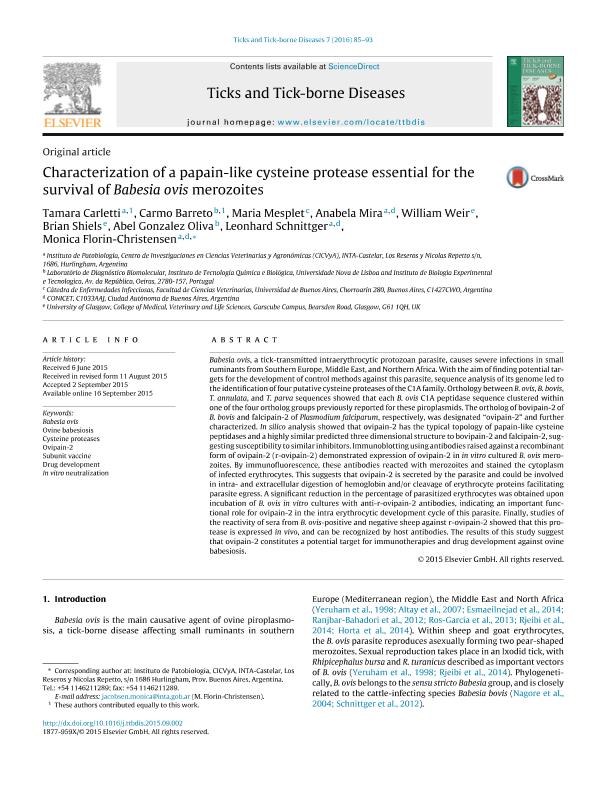Mostrar el registro sencillo del ítem
dc.contributor.author
Carletti, Tamara
dc.contributor.author
Barreto, Carmo
dc.contributor.author
Mesplet, Maria

dc.contributor.author
Mira, Anabela

dc.contributor.author
Weir, William
dc.contributor.author
Shiels, Brian
dc.contributor.author
Gonzalez Oliva, Abel
dc.contributor.author
Schnittger, Leonhard

dc.contributor.author
Jacobsen, Monica Ofelia

dc.date.available
2018-09-04T16:40:23Z
dc.date.issued
2016-02
dc.identifier.citation
Carletti, Tamara; Barreto, Carmo; Mesplet, Maria; Mira, Anabela; Weir, William; et al.; Characterization of a papain-like cysteine protease essential for the survival of Babesia ovis merozoites; Elsevier Gmbh; Ticks and Tick-borne Diseases; 7; 1; 2-2016; 85-93
dc.identifier.issn
1877-9603
dc.identifier.uri
http://hdl.handle.net/11336/58246
dc.description.abstract
Babesia ovis, a tick-transmitted intraerythrocytic protozoan parasite, causes severe infections in small ruminants from Southern Europe, Middle East, and Northern Africa. With the aim of finding potential targets for the development of control methods against this parasite, sequence analysis of its genome led to the identification of four putative cysteine proteases of the C1A family. Orthology between B. ovis, B. bovis, T. annulata, and T. parva sequences showed that each B. ovis C1A peptidase sequence clustered within one of the four ortholog groups previously reported for these piroplasmids. The ortholog of bovipain-2 of B. bovis and falcipain-2 of Plasmodium falciparum, respectively, was designated "ovipain-2" and further characterized. In silico analysis showed that ovipain-2 has the typical topology of papain-like cysteine peptidases and a highly similar predicted three dimensional structure to bovipain-2 and falcipain-2, suggesting susceptibility to similar inhibitors. Immunoblotting using antibodies raised against a recombinant form of ovipain-2 (r-ovipain-2) demonstrated expression of ovipain-2 in in vitro cultured B. ovis merozoites. By immunofluorescence, these antibodies reacted with merozoites and stained the cytoplasm of infected erythrocytes. This suggests that ovipain-2 is secreted by the parasite and could be involved in intra- and extracellular digestion of hemoglobin and/or cleavage of erythrocyte proteins facilitating parasite egress. A significant reduction in the percentage of parasitized erythrocytes was obtained upon incubation of B. ovis in vitro cultures with anti-r-ovipain-2 antibodies, indicating an important functional role for ovipain-2 in the intra erythrocytic development cycle of this parasite. Finally, studies of the reactivity of sera from B. ovis-positive and negative sheep against r-ovipain-2 showed that this protease is expressed in vivo, and can be recognized by host antibodies. The results of this study suggest that ovipain-2 constitutes a potential target for immunotherapies and drug development against ovine babesiosis.
dc.format
application/pdf
dc.language.iso
eng
dc.publisher
Elsevier Gmbh

dc.rights
info:eu-repo/semantics/openAccess
dc.rights.uri
https://creativecommons.org/licenses/by-nc-nd/2.5/ar/
dc.subject
Babesia Ovis
dc.subject
Cysteine Proteases
dc.subject
Drug Development
dc.subject
In Vitro Neutralization
dc.subject
Ovine Babesiosis
dc.subject
Ovipain-2
dc.subject
Subunit Vaccine
dc.subject.classification
Otras Ciencias Veterinarias

dc.subject.classification
Ciencias Veterinarias

dc.subject.classification
CIENCIAS AGRÍCOLAS

dc.title
Characterization of a papain-like cysteine protease essential for the survival of Babesia ovis merozoites
dc.type
info:eu-repo/semantics/article
dc.type
info:ar-repo/semantics/artículo
dc.type
info:eu-repo/semantics/publishedVersion
dc.date.updated
2018-09-04T15:11:53Z
dc.journal.volume
7
dc.journal.number
1
dc.journal.pagination
85-93
dc.journal.pais
Alemania

dc.description.fil
Fil: Carletti, Tamara. Instituto Nacional de Tecnología Agropecuaria. Centro Nacional de Investigaciones Agropecuarias Castelar. Centro de Investigación en Ciencias Veterinarias y Agronómicas. Instituto de Patobiología; Argentina
dc.description.fil
Fil: Barreto, Carmo. Universidade Nova; Portugal. Instituto de Biologia Experimental e Tecnologica; Portugal
dc.description.fil
Fil: Mesplet, Maria. Universidad de Buenos Aires. Facultad de Ciencias Veterinarias; Argentina. Consejo Nacional de Investigaciones Científicas y Técnicas; Argentina
dc.description.fil
Fil: Mira, Anabela. Instituto Nacional de Tecnología Agropecuaria. Centro Nacional de Investigaciones Agropecuarias Castelar. Centro de Investigación en Ciencias Veterinarias y Agronómicas. Instituto de Patobiología; Argentina. Consejo Nacional de Investigaciones Científicas y Técnicas; Argentina
dc.description.fil
Fil: Weir, William. University of Glasgow; Reino Unido
dc.description.fil
Fil: Shiels, Brian. University of Glasgow; Reino Unido
dc.description.fil
Fil: Gonzalez Oliva, Abel. Universidade Nova; Portugal. Instituto de Biologia Experimental e Tecnologica; Portugal
dc.description.fil
Fil: Schnittger, Leonhard. Instituto Nacional de Tecnología Agropecuaria. Centro Nacional de Investigaciones Agropecuarias Castelar. Centro de Investigación en Ciencias Veterinarias y Agronómicas. Instituto de Patobiología; Argentina. Consejo Nacional de Investigaciones Científicas y Técnicas; Argentina
dc.description.fil
Fil: Jacobsen, Monica Ofelia. Instituto Nacional de Tecnología Agropecuaria. Centro Nacional de Investigaciones Agropecuarias Castelar. Centro de Investigación en Ciencias Veterinarias y Agronómicas. Instituto de Patobiología; Argentina. Consejo Nacional de Investigaciones Científicas y Técnicas; Argentina
dc.journal.title
Ticks and Tick-borne Diseases
dc.relation.alternativeid
info:eu-repo/semantics/altIdentifier/doi/http://dx.doi.org/10.1016/j.ttbdis.2015.09.002
dc.relation.alternativeid
info:eu-repo/semantics/altIdentifier/url/https://www.sciencedirect.com/science/article/pii/S1877959X1530008X
Archivos asociados
